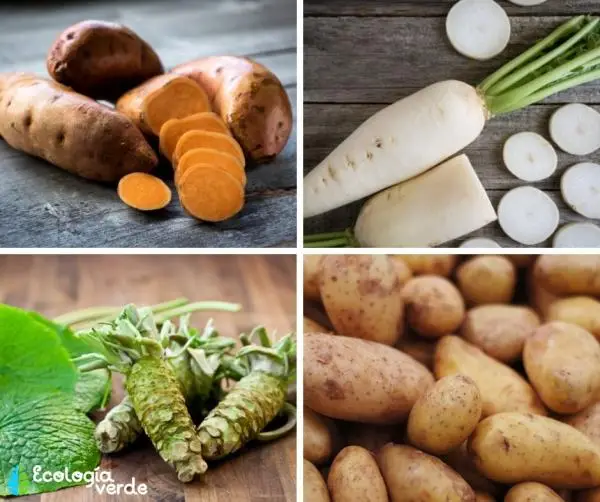The tubers are a very important part of the vegetable products that are consumed today, with examples as representative as the potato or the carrot. These are, in general, highly nutritious parts of plants, with high carbohydrate content and easy to grow, without excessive difficulties.
If you want to learn more about tubers and see some of their most representative examples, join us in this article about what tubers are and examples , with 25 names and photos of some of them.
What are tubers – summary
The tuber is, in the field of botany, part of a root or an underground stem that has specialized for the storage of reserve substances and that, for this, undergoes a marked thickening. Therefore, there are two types of tubers , root and stem, but in both cases it is a thick part in which nutrients and substances for the plant are stored, always partially or fully underground.
As food, they are very nutritious and economically grown vegetables . They are high in starch, which makes them rich in carbohydrates, making them an excellent source of energy.
Types of tubers
As we have mentioned above, there are two main types of tubers . These are its main characteristics:
Stem tubers
They are characterized by forming near the ground surface level. In them, the stem is the part of the plant that thickens and, instead, the roots then grow from the tuber itself. An example of this type of tuber is the carrot.
Root tubers
They are produced from thickening of a section of the root itself. It can happen that the tuber is the entire root or that it affects only some parts, so that a single plant develops several tubers, as is the case of the potato. These types of tubers are also characterized by the fact that if a part of the tuber is cut, each piece can produce a new complete plant, something that does not happen with stem tubers.
Tubers: examples
This is a list of tubers , which includes some of the most popular edible tuber names :
- Arracacha
- Sweet potato or sweet potato
- Chago
- Parsnip
- Tigernut
- Swede
- Turmeric
- Daikon
- Ginseng
- Ginger
- Jicama
- Konjac
- Mashua
- Turnip
- Yam
- Goose
- Olluca
- Potato
- Radish
- Beetroot
- Salsify
- Jerusalem artichoke
- Wasabi
- Yucca
- Carrot
Next, we talk about the characteristics of some of these tubers and show photos of each one.
Sweet potato or sweet potato
Scientific name Ipomoea batatas and also known as sweet potato or sweet potato , it is a tuber that has its origin in South America. Its flesh can be white or orange. depending on the variety, and it has a sweet taste halfway between that of potato and pumpkin.

Tigernut, the tuber of the orchata
This tuber called tigernut or Cyperus esculentus is especially valued in parts of Europe, Africa and the Middle East. Its flavor is sweet and starchy and, although it can be consumed raw, it is much more popular used as an ingredient in tigernut orchata , a highly valued drink in some regions.

Daikon
Also called white radish or Japanese radish , this type of radish is native to eastern and Southeast Asia. By its appearance, Raphanus sativus var. Longipinnatus isreminiscent of a carrot, although somewhat larger in size and totally white in color. Its flavor is milder than that of common radish, and it is a highly valued ingredient in oriental cuisine, both raw and cooked.

Ginseng, a root tuber widely used in medicine
Ginseng is a whole group of species of the genus Panax and it is small and slow growing herbaceous. The most popular species are Panax quinquefolius and Panax ginseng , which are tubers widely used in natural medicine.

Potato
There are few tubers as international and known as the potato . Originally from the Andes and with the scientific name Solanum tuberosum , it is currently one of the most widespread foods on the planet and the fourth most widespread food crop in the world. There are countless varieties with adapted characteristics.

Yam
The yam ( Dioscorea rotundata or white yam and Dioscorea cayenensis or yellow yam , among other varieties) has its origin in Africa and is a starchy tuber whose name means “to eat.” In Africa it has been consumed since prehistoric times and is currently widely spread, especially in South America.

Wasabi, a spicy tuber
Wasabi is obtained from the root of the Wasabi japonica plant , although by this name it is most common to think of the Japanese hot sauce of the same name. This well-known thick sauce is obtained by grating the tuber of this plant and is characteristic for its exceptionally intense and spicy flavor , which is causing it to become more and more popular in more and more countries.

Yucca
The yuca or Manihot esculenta , also called usually tapioca or manioc , originated in South America. Its skin is tough and woody-looking, but its flesh is white and starchy. It is a very important source of carbohydrates in many tropical areas of Asia, America and Africa, just behind rice and corn.

Carrot
Another of the most consumed and cultivated tubers in the world is the carrot or Daucus carota . Most of its varieties are orange in color and what is commonly consumed is the tuberous root , although its leaves are also suitable as food.
